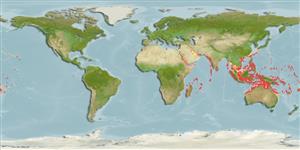Common names from other countries
>
Eupercaria/misc (Various families in series Eupercaria) >
Labridae (Wrasses) > Cheilininae
Etymology: Oxycheilinus: Greek, oxys = sharp + Greek, cheilos = lip.
More on author: Lacepède.
Environment: milieu / climate zone / depth range / distribution range
Ekologi
marina; brackvatten revassocierade; djupintervall 3 - 60 m (Ref. 90102). Tropical; 30°N - 23°S
Indo-Pacific: Red Sea and East Africa to the Marshall Islands and Samoa.
Size / Vikt / Age
Maturity: Lm ? range ? - ? cm
Max length : 40.0 cm SL hane/ej könsbestämd; (Ref. 9823)
Taggstrålar i ryggfenan (totalt): 9; Mjukstrålar i ryggfenan (totalt): 10; Taggstrålar i analfenan 3; Mjukstrålar i analfenan: 8 - 11. Differs from the very similar C. unifasciatus by always lacking the white bar in front of the caudal base as well as the area clear of red streaks extending from the eye to just above the pectoral axis (Ref. 1602).
Found solitary (Ref. 90102) in lagoon and sheltered seaward reefs in coral rich areas (Ref. 1602, 58652). Possibly to 120 m depths. Young is more inshore on sheltered reef crests or slopes, usually amongst soft corals or stinging hydrozoans (Ref. 48635). Feeds on hard-shelled mollusks, crustaceans, and sea urchins (Ref. 27550). The species is observed to swim with a group of goatfish and change its color to resemble these fish, it then darts out from the group to catch small fish (Ref. 2334). This species curiously approaches divers closely (Ref. 90102).
Life cycle and mating behavior
Könsmognad | Reproduktion | Lek | Ägg | Fecundity | Larver
Oviparous, distinct pairing during breeding (Ref. 205).
Randall, J.E., G.R. Allen and R.C. Steene, 1990. Fishes of the Great Barrier Reef and Coral Sea. University of Hawaii Press, Honolulu, Hawaii. 506 p. (Ref. 2334)
IUCN Red List Status (Ref. 130435)
CITES (Ref. 128078)
Not Evaluated
Threat to humans
Harmless
Human uses
Fiskeri: mindre kommeriell; Akvarium: Kommersiell
Ytterligare information
referenserVattenbrukVattenbruksprofilAvelslinjerGenetikElectrophoresesÄrftlighetSjukdomarBehandlingMass conversion
Verktyg
Special reports
Download XML
Internet-källor
Estimates based on models
Preferred temperature (Ref.
115969): 25.4 - 29.1, mean 28 (based on 910 cells).
Phylogenetic diversity index (Ref.
82804): PD
50 = 0.5020 [Uniqueness, from 0.5 = low to 2.0 = high].
Bayesian length-weight: a=0.01905 (0.01013 - 0.03584), b=2.95 (2.78 - 3.12), in cm Total Length, based on LWR estimates for this species & (Sub)family-body (Ref.
93245).
Trofisk nivå (Ref.
69278): 3.7 ±0.4 se; based on diet studies.
Resiliens (Ref.
120179): Låg, lägsta populationsfördubblingstid 4,5-14 år (Preliminary K or Fecundity.).
Fishing Vulnerability (Ref.
59153): Moderate vulnerability (39 of 100).
